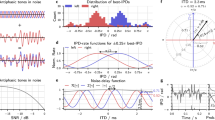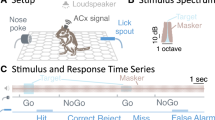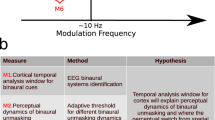Abstract
Humans and animals must often discriminate between complex natural sounds in the presence of competing sounds (maskers). Although the auditory cortex is thought to be important in this task, the impact of maskers on cortical discrimination remains poorly understood. We examined neural responses in zebra finch (Taeniopygia guttata) field L (homologous to primary auditory cortex) to target birdsongs that were embedded in three different maskers (broadband noise, modulated noise and birdsong chorus). We found two distinct forms of interference in the neural responses: the addition of spurious spikes occurring primarily during the silent gaps between song syllables and the suppression of informative spikes occurring primarily during the syllables. Both effects systematically degraded neural discrimination as the target intensity decreased relative to that of the masker. The behavioral performance of songbirds degraded in a parallel manner. Our results identify neural interference that could explain the perceptual interference at the heart of the cocktail party problem.
This is a preview of subscription content, access via your institution
Access options
Subscribe to this journal
Receive 12 print issues and online access
$209.00 per year
only $17.42 per issue
Buy this article
- Purchase on Springer Link
- Instant access to full article PDF
Prices may be subject to local taxes which are calculated during checkout




Similar content being viewed by others
References
Hulse, S.H., MacDougall-Shackleton, S.A. & Wisniewski, A.B. Auditory scene analysis by songbirds: stream segregation of birdsong by European starlings (Sturnus vulgaris). J. Comp. Psychol. 111, 3–13 (1997).
Endepols, H., Feng, A.S., Gerhardt, H.C., Schul, J. & Walkowiak, W. Roles of the auditory midbrain and thalamus in selective phonotaxis in female gray tree frogs (Hyla versicolor). Behav. Brain Res. 145, 63–77 (2003).
Cherry, E.C. Some experiments on the recognition of speech, with one and with two Ears. J. Acoust. Soc. Am. 25, 975–979 (1953).
Bronkhorst, A.W. The cocktail party phenomenon: a review of research on speech intelligibility in multiple-talker conditions. Acustica 86, 694–703 (2000).
Asari, H., Pearlmutter, B.A. & Zador, A.M. Sparse representations for the cocktail party problem. J. Neurosci. 26, 7477–7490 (2006).
Haykin, S. & Chen, Z. The cocktail party problem. Neural Comput. 17, 1875–1902 (2005).
Bronkhorst, A.W. & Plomp, R. Effect of multiple speech-like maskers on binaural speech recognition in normal and impaired hearing. J. Acoust. Soc. Am. 92, 3132–3139 (1992).
Brungart, D.S., Simpson, B.D., Ericson, M.A. & Scott, K.R. Informational and energetic masking effects in the perception of multiple simultaneous talkers. J. Acoust. Soc. Am. 110, 2527–2538 (2001).
Kidd, G., Jr, Mason, C.R., Rohtla, T.L. & Deliwala, P.S. Release from masking due to spatial separation of sources in the identification of nonspeech auditory patterns. J. Acoust. Soc. Am. 104, 422–431 (1998).
Bar-Yosef, O., Rotman, Y. & Nelken, I. Responses of neurons in cat primary auditory cortex to bird chirps: effects of temporal and spectral context. J. Neurosci. 22, 8619–8632 (2002).
Narayan, R., Grana, G. & Sen, K. Distinct time scales in cortical discrimination of natural sounds in songbirds. J. Neurophysiol. 96, 252–258 (2006).
Nelken, I. Processing of complex stimuli and natural scenes in the auditory cortex. Curr. Opin. Neurobiol. 14, 474–480 (2004).
Wang, L., Narayan, R., Grana, G., Shamir, M. & Sen, K. Cortical discrimination of complex natural stimuli: can single neurons match behavior? J. Neurosci. 27, 582–589 (2007).
Doupe, A.J. & Kuhl, P.K. Birdsong and human speech: common themes and mechanisms. Annu. Rev. Neurosci. 22, 567–631 (1999).
Grace, J.A., Amin, N., Singh, N.C. & Theunissen, F.E. Selectivity for conspecific song in the zebra finch auditory forebrain. J. Neurophysiol. 89, 472–487 (2003).
Woolley, S.M., Fremouw, T.E., Hsu, A. & Theunissen, F.E. Tuning for spectro-temporal modulations as a mechanism for auditory discrimination of natural sounds. Nat. Neurosci. 8, 1371–1379 (2005).
Best, V., Ozmeral, E., Gallun, F.J., Sen, K. & Shinn-Cunningham, B.G. Spatial unmasking of birdsong in human listeners: energetic and informational factors. J. Acoust. Soc. Am. 118, 3766–3773 (2005).
Appeltants, D., Gentner, T.Q., Hulse, S.H., Balthazart, J. & Ball, G.F. The effect of auditory distractors on song discrimination in male canaries (Serinus canaria). Behav. Processes 69, 331–341 (2005).
Carhart, R., Tillman, T.W. & Greetis, E.S. Perceptual masking in multiple sound backgrounds. J. Acoust. Soc. Am. 45, 694–703 (1969).
Fitch, R.H., Miller, S. & Tallal, P. Neurobiology of speech perception. Annu. Rev. Neurosci. 20, 331–353 (1997).
Rauschecker, J.P. Cortical processing of complex sounds. Curr. Opin. Neurobiol. 8, 516–521 (1998).
Langner, G., Bonke, D. & Scheich, H. Neuronal discrimination of natural and synthetic vowels in field L of trained mynah birds. Exp. Brain Res. 43, 11–24 (1981).
Lewicki, M.S. & Arthur, B.J. Hierarchical organization of auditory temporal context sensitivity. J. Neurosci. 16, 6987–6998 (1996).
Muller, C.M. & Leppelsack, H.J. Feature extraction and tonotopic organization in the avian auditory forebrain. Exp. Brain Res. 59, 587–599 (1985).
Scheich, H., Langner, G. & Bonke, D. Responsiveness of units in the auditory neostriatum of the guinea fowl (Numida meleagris) to species-specific calls and synthetic stimuli. II. Discrimination of Iambus-like calls. J. Comp. Physiol. A Neuroethol. Sens. Neural. Behav. Physiol. 132, 257–276 (1979b).
Sen, K., Theunissen, F.E. & Doupe, A.J. Feature analysis of natural sounds in the songbird auditory forebrain. J. Neurophysiol. 86, 1445–1458 (2001).
Theunissen, F.E., Sen, K. & Doupe, A.J. Spectral-temporal receptive fields of nonlinear auditory neurons obtained using natural sounds. J. Neurosci. 20, 2315–2331 (2000).
Nelken, I., Fishbach, A., Las, L., Ulanovsky, N. & Farkas, D. Primary auditory cortex of cats: feature detection or something else? Biol. Cybern. 89, 397–406 (2003).
Verhey, J.L., Pressnitzer, D. & Winter, I.M. The psychophysics and physiology of comodulation masking release. Exp. Brain Res. 153, 405–417 (2003).
McAlpine, D., Jiang, D. & Palmer, A.R. Binaural masking level differences in the inferior colliculus of the guinea pig. J. Acoust. Soc. Am. 100, 490–503 (1996).
Jiang, D., McAlpine, D. & Palmer, A.R. Responses of neurons in the inferior colliculus to binaural masking level difference stimuli measured by rate-versus-level functions. J. Neurophysiol. 77, 3085–3106 (1997).
Ratnam, R. & Feng, A.S. Detection of auditory signals by frog inferior collicular neurons in the presence of spatially separated noise. J. Neurophysiol. 80, 2848–2859 (1998).
Palmer, A.R., Jiang, D. & McAlpine, D. Desynchronizing responses to correlated noise: a mechanism for binaural masking level differences at the inferior colliculus. J. Neurophysiol. 81, 722–734 (1999).
Lin, W.Y. & Feng, A.S. Free-field unmasking response characteristics of frog auditory nerve fibers: comparison with the responses of midbrain auditory neurons. J. Comp. Physiol. [A] 187, 699–712 (2001).
Pressnitzer, D., Meddis, R., Delahaye, R. & Winter, I.M. Physiological correlates of comodulation masking release in the mammalian ventral cochlear nucleus. J. Neurosci. 21, 6377–6386 (2001).
Neuert, V., Verhey, J.L. & Winter, I.M. Responses of dorsal cochlear nucleus neurons to signals in the presence of modulated maskers. J. Neurosci. 24, 5789–5797 (2004).
Lane, C.C. & Delgutte, B. Neural correlates and mechanisms of spatial release from masking: single-unit and population responses in the inferior colliculus. J. Neurophysiol. 94, 1180–1198 (2005).
Ramachandran, R., Davis, K.A. & May, B.J. Rate representation of tones in noise in the inferior colliculus of decerebrate cats. J. Assoc. Res. Otolaryngol. 1, 144–160 (2000).
Las, L., Stern, E.A. & Nelken, I. Representation of tone in fluctuating maskers in the ascending auditory system. J. Neurosci. 25, 1503–1513 (2005).
Phillips, D.P. & Cynader, M.S. Some neural mechanisms in the cat's auditory cortex underlying sensitivity to combined tone and wide-spectrum noise stimuli. Hear. Res. 18, 87–102 (1985).
Nelken, I., Rotman, Y. & Bar Yosef, O. Responses of auditory-cortex neurons to structural features of natural sounds. Nature 397, 154–157 (1999).
Furukawa, S., Xu, L. & Middlebrooks, J.C. Coding of sound-source location by ensembles of cortical neurons. J. Neurosci. 20, 1216–1228 (2000).
Nieder, A. & Klump, G.M. Signal detection in amplitude-modulated maskers. II. Processing in the songbird's auditory forebrain. Eur. J. Neurosci. 13, 1033–1044 (2001).
Hofer, S.B. & Klump, G.M. Within- and across-channel processing in auditory masking: a physiological study in the songbird forebrain. J. Neurosci. 23, 5732–5739 (2003).
Machens, C.K., Wehr, M.S. & Zador, A.M. Linearity of cortical receptive fields measured with natural sounds. J. Neurosci. 24, 1089–1100 (2004).
Britten, K.H., Shadlen, M.N., Newsome, W.T. & Movshon, J.A. The analysis of visual motion: a comparison of neuronal and psychophysical performance. J. Neurosci. 12, 4745–4765 (1992).
Romo, R. & Salinas, E. Flutter discrimination: neural codes, perception, memory and decision making. Nat. Rev. Neurosci. 4, 203–218 (2003).
Fortune, E.S. & Margoliash, D. Cytoarchitectonic organization and morphology of cells of the field L complex in male zebra finches (Taenopygia guttata). J. Comp. Neurol. 325, 388–404 (1992).
van Rossum, M.C. A novel spike distance. Neural Comput. 13, 751–763 (2001).
Machens, C.K. et al. Single auditory neurons rapidly discriminate conspecific communication signals. Nat. Neurosci. 6, 341–342 (2003).
Acknowledgements
This work was supported by the US National Institute on Deafness and Other Communication Disorders grant 1 RO1 DC–007610–01A1 (K.S.), the Deafness Research Foundation and the National Organization for Hearing Research Foundation (M.D.), and the Air Force Office of Scientific Research grant FA9550–04–1–0260 (B.S.-C.).
Author information
Authors and Affiliations
Contributions
K.S., B.S.-C., M.D., R.N., V.B and E.O. designed the research. R.N. carried out the neurophysiology experiments and analyzed the neural data. V.B. analyzed the behavioral data and assisted in the neurophysiology experiments. E.O. generated stimuli and assisted in the neurophysiology experiments. E.M. and M.D. carried out the behavioral experiments. M.D. supervised the behavioral experiments. K.S. supervised the neurophysiology experiments. K.S., V.B. and R.N. wrote the manuscript.
Corresponding author
Supplementary information
Supplementary Text and Figures
Supplementary Figures 1–3 (PDF 204 kb)
Rights and permissions
About this article
Cite this article
Narayan, R., Best, V., Ozmeral, E. et al. Cortical interference effects in the cocktail party problem. Nat Neurosci 10, 1601–1607 (2007). https://doi.org/10.1038/nn2009
Received:
Accepted:
Published:
Issue Date:
DOI: https://doi.org/10.1038/nn2009
This article is cited by
-
Parvalbumin neurons enhance temporal coding and reduce cortical noise in complex auditory scenes
Communications Biology (2023)
-
Biologically plausible single-layer networks for nonnegative independent component analysis
Biological Cybernetics (2022)
-
Adaptation of the human auditory cortex to changing background noise
Nature Communications (2019)
-
Vocal sequences suppress spiking in the bat auditory cortex while evoking concomitant steady-state local field potentials
Scientific Reports (2016)
-
Cross-modal integration of multimodal courtship signals in a wolf spider
Animal Cognition (2016)



